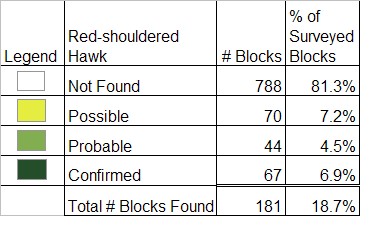Find a Bird - BBA1
Breeding Bird Atlas 1 Species Accounts
Red-shouldered Hawk
Buteo lineatus
Egg Dates
April 3 to June 5
Number of Broods
one; may re-lay if first attempt fails.

The Red-shouldered Hawk was largely absent from Massachusetts until about 1870. It began increasing rapidly after 1885 and by the early 1900s had become one of the commonest hawks in the state. The population remained high until 1940 but by 1960 had declined to its present level due to a combination of factors including pesticides and habitat destruction. Red-shouldered Hawks nest sparingly throughout the state, except on Cape Cod, Martha’s Vineyard, and Nantucket, where they are absent. The species is most numerous in western Massachusetts.
The Red-shouldered Hawk is a bird of lowland forest and swampy areas. The ideal habitat seems to be associated with Beaver ponds and adjacent streams, with mature hardwoods nearby to provide nesting sites. Seclusion from human disturbance is usually a requisite for successful breeding. Sections of southern Berkshire County and Quabbin have an abundance of this type of habitat.
Red-shouldered Hawks are among the first birds to return to our area in spring, arriving about the same time as male Red-winged Blackbirds. In Quabbin, they first appear at territories during early March, when most adults are already paired. The land is usually still snow covered and the lakes and ponds frozen. The birds often seek open water in swamps or inlets of ponds that thaw early. At these locations, they can be seen hunting from low perches near the water’s edge. Areas that harbor breeding Wood Frogs, presumed important early-spring food items, are good places to look for one. This buteo has relatively long legs that are used to good advantage in catching amphibians in swampy habitat. More northern nesting individuals pass through Massachusetts, with a peak occurring in late March.
The Red-shouldered Hawk is extremely faithful to its nesting territory and returns year after year to the same woodlot. The nest from the previous season is often repaired and reused, not uncommonly for seven or more years in a row. The string is broken usually when the structure grows too old and rotten to withstand the winter snow and falls to the ground. If the prior year’s nesting attempt failed, then a new site generally is selected the next spring. Also, if the eggs or young chicks are lost, the pair will renest nearby the same season.
The nest site is usually in a stand of mature deciduous trees. In Berkshire County, the American Beech is a favored tree, followed by Red Oak, Yellow Birch, and White Birch in that order. Heights of 39 nests ranged from 24 to 60 feet, with an average of 42 feet. In Quabbin, the preferred tree species are Black and Yellow birches. Nest heights of 12 nests ranged from 30 to 48 feet (average 39 feet). Open hardwood forest is favored over mixed hardwood-softwood stands.
Nest building or repairing is a leisurely process for this hawk, sometimes with as much as six weeks passing before eggs are laid. Nests are constructed of sticks in a main crotch of a tree close to the trunk. Sometime during March or early April, old nests will receive a fresh green sprig, usually a bough from an Eastern Hemlock or a pine. More than one alternate nest may be marked this way so that it is not always possible at that point to determine which nest will actually be used.
Each pair of Red-shouldered Hawks requires a territory of about 1 square mile, from which they will evict all conspecific species. Barred Owls and Broad-winged Hawks are tolerated; but the Red-tailed Hawk is antagonistic, and the Great Horned Owl is a serious predator. Active nests in Quabbin were spaced an average of 1 mile apart.
The call of the Red-shouldered Hawk, which brings to mind a walk through a leafless wood in early spring, can be described as kee-cow, clear and ringing, often repeated several times. Blue Jays can mimic this call almost perfectly. During courtship in March and April (most often in mid-March), this vocalization is repeated while the pair performs aerial courtship displays. Once eggs are laid, the calling ceases, and for the rest of the season the birds keep a low profile.
Clutch size ranges from two to four, with an average of three eggs for 9 Quabbin nests. The eggs are the size of those of a domestic hen and are marked with large brown splotches. Some pairs in eastern Massachusetts may have eggs by late March. Most eggs are laid from early to mid-April. Incubation, which starts with the first egg, lasts about 28 days and is accomplished by the female. The time of hatching varies by 1 or 2 days. Quabbin eggs have hatched between May 8 and May 24. The young remain in the nest for approximately six weeks. Eastern Chipmunks are an important food for the nestlings.
In a sample of 5 Massachusetts nests, 4 had two nestlings and 1 had three nestlings (Olmstead). The average number of young per successful Berkshire nest was two in a sample of 72 nests. Fledging there occurred about June 20. In Quabbin, the young have left the nest from June 25 to July 5. At 5 nests, ten of fourteen hatchlings fledged. Most mortality was due to Great Horned Owl predation and severe weather.
The family stays together well into August, but the birds rarely are seen, and little is known about their habits during this period. Some groups become vocal again by late summer. By September, they have gone their separate ways. Fall migration peaks in late October. The birds winter mainly in the southern states, but an occasional straggler will remain in Massachusetts.
Map Legend and Data Summary
Atlas 1 data collected from 1975-1979


Note: uncommon in moist woodlands and wooded swamps; virtually absent on Cape and Islands
Joseph MacDonald



